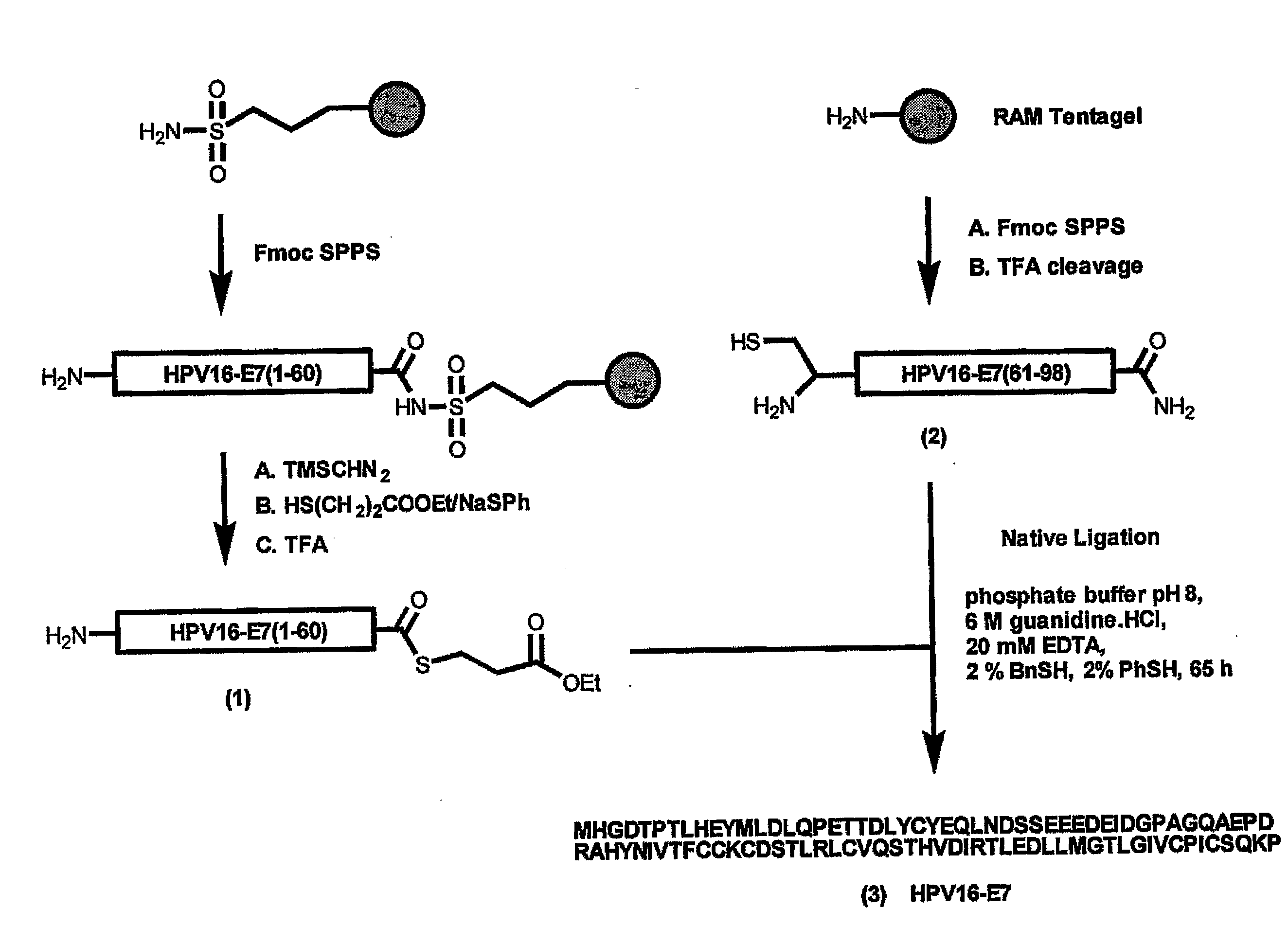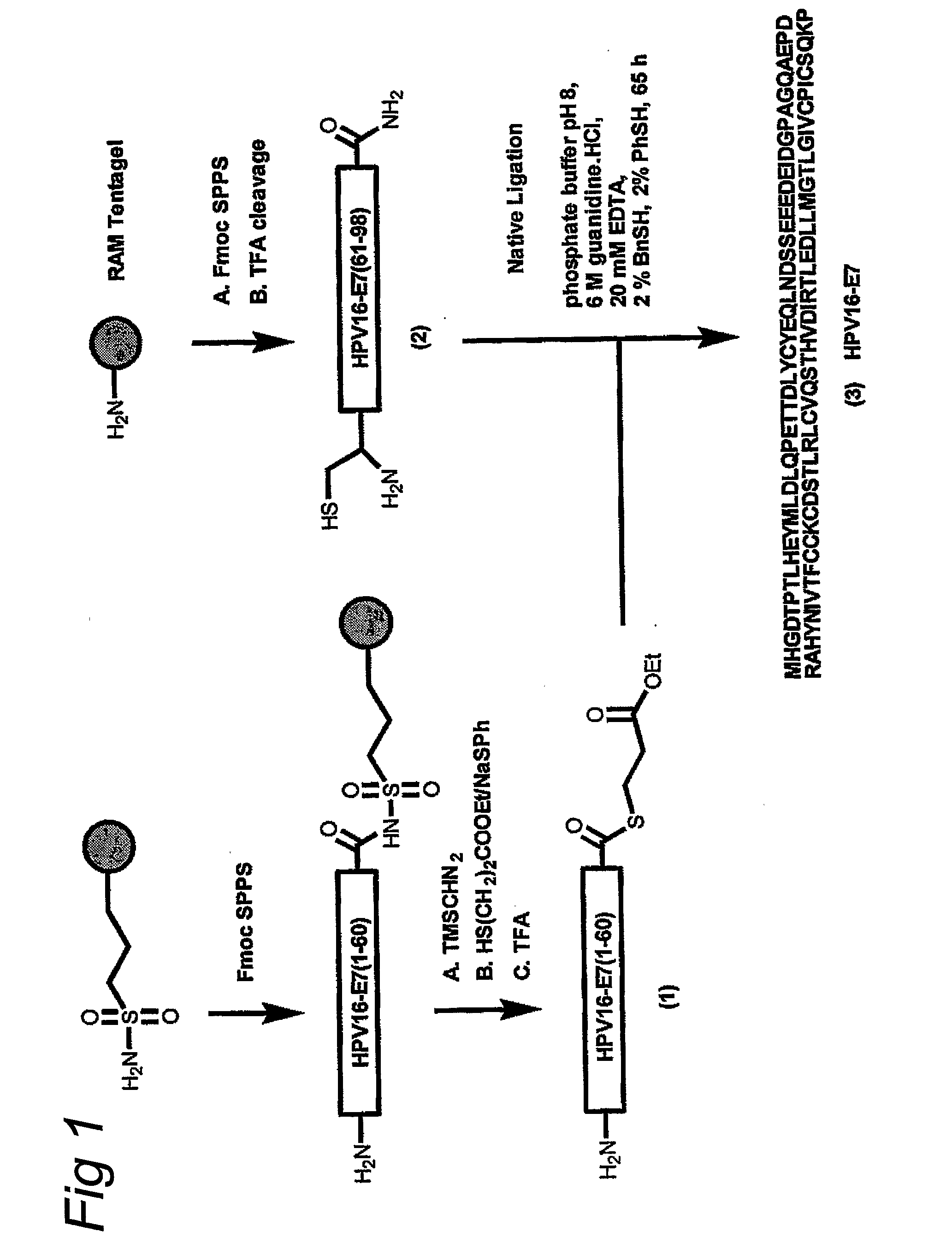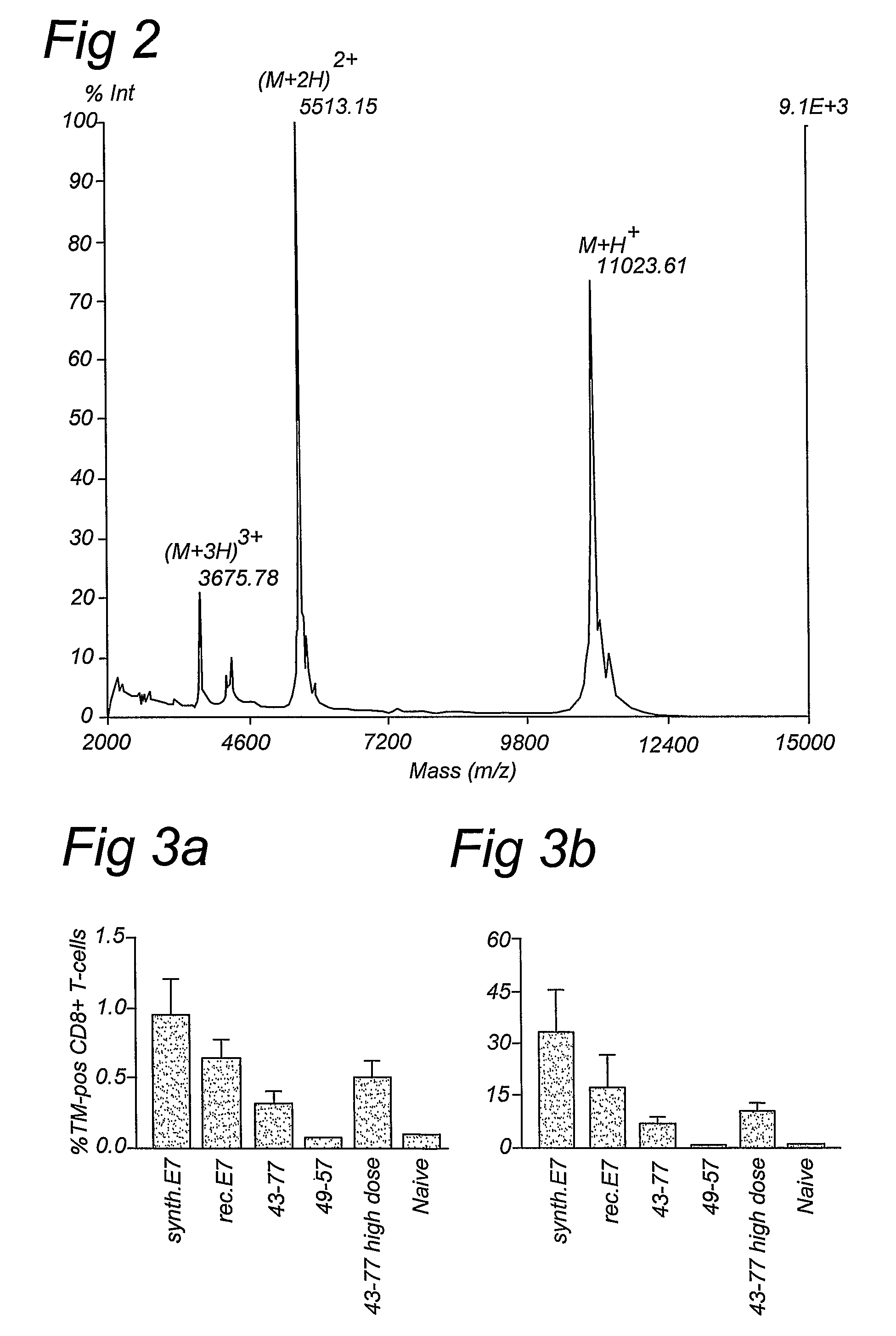Synthetic Protein as Tumor-Specific Vaccine
a technology of synthetic protein and tumor-specific vaccine, which is applied in the field of medicine, can solve the problems of inability to immunize patients, affecting the immunogenic effect of patients, and requiring extensive purification and quality control, and achieving the effect of reducing the risk of infection, and reducing the effect of immunogenicity
- Summary
- Abstract
- Description
- Claims
- Application Information
AI Technical Summary
Benefits of technology
Problems solved by technology
Method used
Image
Examples
example 1
Chemical Synthesis of HPV16 E7 Peptides and Ligation of Peptides Chemical Synthesis of HPV 16 E7 Peptides and Protein
[0054]The homogeneous synthetic E7 protein was prepared by chemical ligation of two oligopeptides assembled separately by Fmoc solid phase synthesis. The N-terminal 60-meric segment of E7 was prepared on sulphonamide safety-catch resin and converted into thioester 1 [E7 (1-60)] according to a published procedure (Ingenito, R et al., J. Am. Chem. Soc. 121, 11369-11374 (1999). The C-terminal 38-meric carboxamide [E7(61-98), 2] was produced via a standard Fmoc solid phase protocol. Subsequently, the RP-HPLC purified fragments 1 and 2 were ligated to give the full-length E7 protein (3). The ligation reaction could be successfully conducted using thiophenol / benzyl mercaptane as additives according to the one of the original native ligation procedures (Hackeng T. M., et al, Proc. Natl. Acad. Sci. USA 96, 10068-10073 (1999) and Dawson, P. E., et al., J. Am. Chem. Soc. 119, 4...
example 2
Chemical Synthesis of HPV16 E6
[0062]
HPV16-E6 PROTEIN SEQUENCE001MHQKRTAMFQ DPQERPRKLP QLCTELQTTI HDIILECVYC KQQLLRREVY DFAFRDLCIV061YRDGNPYAVC DKCLKFYSKI SEYRHYCYSL YGTTLEQQYN KPLCDLLIRC INCQKPLCPE121EKQRHLDKKQ RFHNIRGRWT GRCMSCCRSS RTRRETQL
[0063]Four fragments selected for peptide synthesis to obtain full length HPV16E6 synthetic protein:
01:001-039MHQKRTAMFQDPQERPRKLPQLCTELQTTIHDIILECVY-SR02:040-072X-CKQQLLRREVYDFAFRDLCIVYRDGNPYAVCDK-SR03:073-117X-CLKFYSKISEYRHYCYSLYGTTLEQQYNKPLCDLLIRCINCQKPL-SR04:118-158CPEEKQRHLDKKQRFHNIRGRWTGRCMSCCRSSRTRRETQL-OH
[0064]The fragments are depicted as their thioesters (-SR) wherein X represents a temporary protecting group that is removed after the particular fragment has been coupled (e.g. the MSC-group). The synthesis process is: coupling fragment 04 to fragment 03, followed by removal X from construct 03 / 04, coupling fragment 03 / 04 to fragment 02, removal X from construct 02 / 03 / 04, coupling fragment 02 / 03 / 04 to fragment 01.
example 3
Chemical Synthesis of HPV16 E2
[0065]
HPV16-E2 PROTEIN SEQUENCE001METLCQRLNV CQDKILTHYE NDSTDLRDHI DYWKHMRLEC AIYYKAREMG FKHINHQVVP061TLAVSKNKAL QAIELQLTLE TIYNSQYSNE KWTLQDVSLE VYLTAPTGCI KKHGYTVEVQ121FDGDICNTMH YTNWTHIYIC EEASVTVVEG QVDYYGLYYV HEGIRTYFVQ FKDDAEKYSK181NKVWEVHAGG QVILCPTSVF SSNEVSSPEI IRQHLANHPA ATHTKAVALG TEETQTTIQR241PRSEPDTGNP CHTTKLLHRD SVDSAPILTA FNSSHKGRIN CNSNTTPIVH LKGDANTLKC301LRYRFKKHCT LYTAVSSTWH WTGHNVKHKS AIVTLTYDSE WQRDQFLSQV KIPKTITVST361GFMSI
[0066]Seven fragments selected for peptide synthesis to obtain full length HPV16 E2 synthetic protein:
01:001-039METLCQRLNVCQDKILTHYENDSTDLRDHIDYWKHMRLE-SR02:040-108X-CAIYYKAREMGFKHINHQVVPTLAVSKNKALQAIELQLTLETIYNSQYSNEKWTLQDVSLEVYLTAPTG-SR03:109-139X-CIKKHGYTVEVQFDGDICNTMHYTNWTHIYI-SR04:140-194X-CEEASVTVVEGQVDYYGLYYVHEGIRTYFVQFKDDAEKYSKNKVWEVHAGGQVIL-SR05:195-250X-CPTSVFSSNEVSSPEIIRQHLANHPAATHTKAVALGTEETQTTIQRPRSEPDTGNP-SR06:251-299X-CHTTKLLHRDSVDSAPILTAFNSSHKGRINCNSNTTPIVHLKGDANTLK-SR07:300-365CLRYRFKKHCTLYTAVSSTWH...
PUM
| Property | Measurement | Unit |
|---|---|---|
| Fraction | aaaaa | aaaaa |
| Pharmaceutically acceptable | aaaaa | aaaaa |
Abstract
Description
Claims
Application Information
 Login to View More
Login to View More - R&D
- Intellectual Property
- Life Sciences
- Materials
- Tech Scout
- Unparalleled Data Quality
- Higher Quality Content
- 60% Fewer Hallucinations
Browse by: Latest US Patents, China's latest patents, Technical Efficacy Thesaurus, Application Domain, Technology Topic, Popular Technical Reports.
© 2025 PatSnap. All rights reserved.Legal|Privacy policy|Modern Slavery Act Transparency Statement|Sitemap|About US| Contact US: help@patsnap.com



